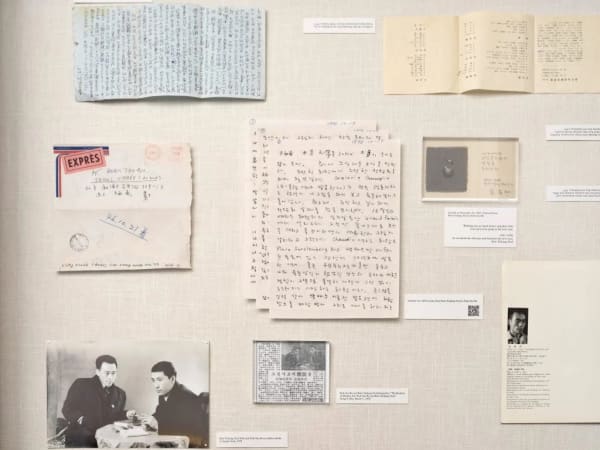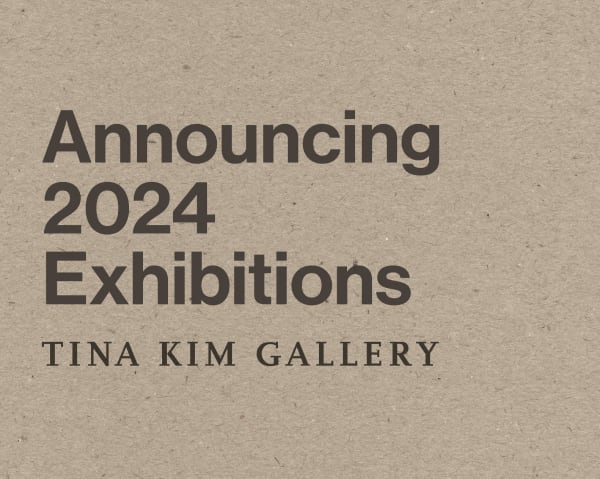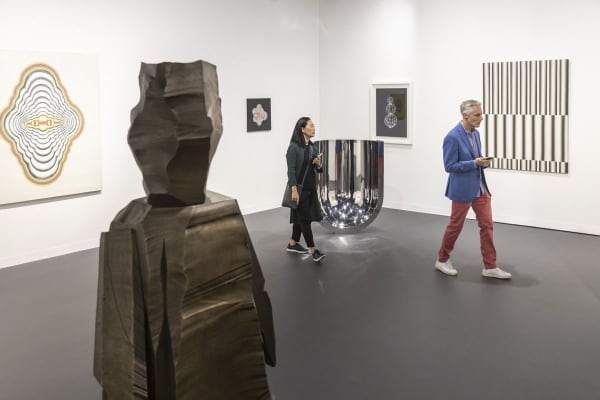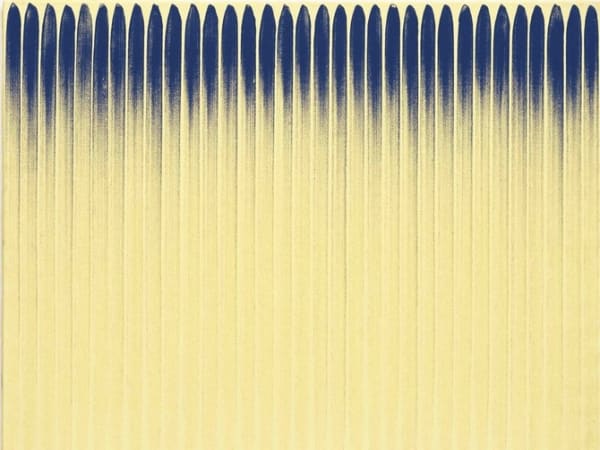Lee Ufan (b. 1936), a key figure in the Korean Dansaekhwa movement, has dedicated his career to exploring themes of contemplation, repetition, and temporality. In 1956, after enrolling at Seoul National University, Lee withdrew from his studies just two and a half months later to pursue philosophy at Nihon University in Tokyo. His relocation to Tokyo facilitated formative encounters with fellow artists and critics, leading to the formation of Mono-ha. The movement’s writings and artworks examined spatial relationships between objects, particularly natural and industrial materials, exemplified by Lee’s ongoing “Relatum” sculpture series, which began in 1968. Parallel to his sculptural work, Lee’s paintings—including the renowned “From Line” and “From Point” series, both of which began in the 1970s—embody the principles of Dansaekhwa through repetitive, minimal brushstrokes and meditative gestures that focus on the act of painting itself.
Lee’s works are part of many institutional collections across the world, including the National Museum of Modern Art in Tokyo, the Tate Modern Gallery in London, The Museum of Modern Art in New York, the Guggenheim Museum in New York, and the National Museum of Modern and Contemporary Art in Seoul. The Lee Ufan Museum, which opened in Naoshima, Japan in 2010, was designed by architect Tadao Ando and is dedicated to the artist’s work. It is complemented by Space Lee Ufan at Busan Museum, established in 2015, and Lee Ufan Arles, which opened in France in 2022. In addition to his painting and sculpture, Lee is also a prolific theorist who has published extensively in the areas of art history, art criticism, poetry, and philosophy.
-

Lee Ufan: Quiet Resonance
Art Gallery NSW 31 Aug 2024 - 7 Sep 2025Within spaces designed by the artist, this exhibition by Lee Ufan distils over six decades of considered experimentation into a series of recent paintings and sculptures created especially for the...Learn More -

Lee Ufan
Hamburger Bahnhof 27 Oct 2023 - 28 Apr 2024Hamburger Bahnhof presents the first comprehensive retrospective of the painter and sculptor Lee Ufan in Germany. Lee is one of the most important representatives of the Mono-ha school in Japan...Learn More -

Abstraction and Calligraphy − Towards a Universal Language featuring Lee Ufan
Louvre Abu Dhabi 17 Feb - 12 Jun 2021In collaboration with Centre Pompidou What’s the driving force behind Cy Twombly’s emotive expressions? Behind Kandinsky’s vibrant canvases? Abstract artists set out to form a universal language that could be...Learn More -

Korean Abstract Art: Kim Whanki and Dansaekhwa
Powerlong Museum, Shanghai 8 Nov 2018 - 2 Mar 2019Curator: Wang Chunjie Participating artists: Kim Whanki, Kwon Young-Woo, Chung Chang-Sup, Park Seo-Bo, Chung Sang-Hwa, Ha Chong-Hyun, Lee Ufan 'Shanghai’s Powerlong Museum is pleased to announce Korean Abstract Art: Kim...Learn More -

Rhythm in Monochrome | Korean Abstract Painting
Tokyo Opera City Art Gallery 14 Oct - 24 Dec 2017Rhythm in Monochrome: Korean Abstract Painting at the Tokyo Opera City Art Gallery. This exhibition features Kim Whanki, Kwon Young-Woo, Chung Chang-Sup, Park Seo-Bo, Chung Sang-Hwa, Ha Chong-Hyun, and Lee...Learn More -

When Process Becomes Form: Dansaekhwa and Korean Abstraction
The Boghossian Foundation 20 Feb - 24 Apr 2016Kukje Gallery / Tina Kim Gallery and The Boghossian Foundation – Villa Empain present: When Process Becomes Form: Dansaekhwa and Korean Abstraction Chung Chang-Sup, Chung Sang-Hwa, Ha Chong-Hyun, Kim Whanki,...Learn More -

Dansaekhwa In Venice
Collateral Event of the 56th International Art Exhibition 15 May - 18 Aug 2015Learn More
-

How Four Korean Artists Blazed a Path to Global Recognition—One Letter at a Time
Artnet June 6, 2025“Our generation seems fated for tragedy, but there is something to be said about living through history,” the artist Park Seo-Bo wrote to his friend,...Learn More -

Lee Ufan on art, technology, and the metaphysical
Artforum December 21, 2024For this month’s episode of “Under the Cover,” artist Lee Ufan stops by the Artforum offices to speak with Editor in Chief Tina Rivers Ryan...Learn More -

Lee Ufan Forges Meaning from Emptiness
Ocula September 6, 2024New works by Korean artist Lee Ufan bring the rich hues of Australia's natural landscape into view at the Art Gallery of New South Wales...Learn More -

Interview | Pas de deux between Mark Rothko and Lee Ufan
The Korea Times September 3, 2024'I think we're the three people left in the world who knew Mark Rothko.' It was a Monday morning in Seoul, the air fresh after...Learn More -

Announcing 2024 Exhibitions
January 5, 2024Tina Kim Gallery is proud to announce our 2024 programming. Our spring season begins with a solo exhibition of Amsterdam-based artist Jennifer Tee , whose...Learn More -

The Essential Works of Lee Ufan
Art Asia Pacific August 5, 2022“Art is poetry, criticism, and the transcendent. There are two different paths that lead to it. One is the embodiment of one’s internal images. The...Learn More -

Legendary Korean Artist Lee Ufan Sets Up a Dazzling New Museum for His Art in Southern France
Art News May 11, 2022Since the late 19th-century when Impressionists, most notably Vincent van Gogh, flocked there, Arles has long fascinated artists and the art world by extension. More...Learn More -

A Full View, at Last, of Modern Art in South Korea
The New York Times June 25, 2020Many rich nations use art, music and movies to project an image to the world, but few take it as seriously as South Korea —...Learn More -

8 Fascinating Finds from the FOG Design+Art Fair in San Francisco
Galerie Magazine January 15, 2020The booming tech industry has yielded a crop of new collectors who favor younger new-media artists, as well as those bridging utilitarian design with sculptural...Learn More -

The 10 Best Booths at Art Basel in Miami Beach
Artsy December 5, 2019For her first-ever solo presentation at Art Basel in Miami Beach, Tina Kim selected a handful of Dansekhwa (Korean minimalist) works in addition to stranger,...Learn More -

The Hottest Art Genre Right Now May Surprise You
Architectural Digest May 5, 2017By Guelda Voien Korean abstract painting, a post-war development often lumped under the umbrella term Dansaekhwa, has exploded in popularity in the last five years....Learn More -

Skin & Surface What is Dansaekhwa and what is its legacy today?
Frieze February 20, 2015By Yoon Jin Sup, Joan Kee, Sam Bardaouil, and Till Rellrath '...Tansaekhwa artists regarded themselves as painters, yet their kind of painting had little to...Learn More




















